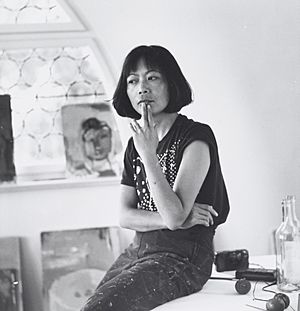Leiko Ikemura facts for kids
Quick facts for kids
Leiko Ikemura
|
|
|---|---|
 |
|
| Born | 22 August 1951 Tsu, Mie Prefecture, Japan
|
| Nationality | Japanese/Swiss |
| Alma mater | Academia de Bellas Artes, Spain |
| Known for | Melbourne International Biennial 1999 |
| Style | painting, sculpture, drawing, watercolor, prints, and photography |
Leiko Ikemura (イケムラレイコ, Ikemura Reiko, born 22 August 1951) is a Japanese-Swiss artist famous for creating art that looks like it's from a magical world. She makes paintings, sculptures, and drawings that often mix together humans, animals, and plants.
Ikemura has been an important artist since the 1970s. She is known for being part of a style called Neo-Expressionism, which uses strong colors and emotions. Her art is shown in famous museums all over the world, like the Centre Pompidou in Paris and the National Museum of Modern Art, Tokyo.
Contents
The Artist's Journey
Leiko Ikemura was born in Japan. After studying Spanish at Osaka University, she moved to Spain in 1973 to study art. This was the beginning of her life as an international artist.
In 1979, she moved to Zurich, Switzerland, to start her career. Her first big solo show was in Bonn, Germany, in 1983. A few years later, she moved to Germany and began making sculptures out of materials like bronze and ceramic.
Since 1991, Ikemura has also been a professor, teaching painting to new artists at the Berlin University of the Arts. She now lives and works in Berlin and Cologne, Germany. She feels that both Japan and Switzerland are her homes.
Exploring Art and Ideas
Ikemura uses many different materials for her art, including paint, clay, and even video. Her style has changed over the years, but she often explores similar ideas and themes in her work.
Some of her early inspirations were famous artists like Matisse and Picasso. However, she developed her own unique style. Her art often combines ideas from both Japanese and European cultures, making it special and hard to categorize.
Starting with Drawings
When Ikemura began her career in Switzerland, she mostly made drawings. For her, drawing is not just a sketch for a bigger project. Each drawing is a complete work of art on its own.
She has said that drawing feels "immediate and honest." She loves how many different styles of drawing are possible. Her drawings from different times in her life look so different that it seems like they were made by different people.
Painting New Worlds
In the 1980s, Ikemura started to focus more on painting. She began creating large paintings made of three separate panels, called triptychs. This format was often used in old European religious art.
Ikemura used triptychs to mix landscapes from Europe with scenes from Japan. For example, her work Genesis shows a famous old road in Japan called the Tōkaidō. By naming it Genesis, she connects a Japanese landmark with a story from the Bible, creating a new and interesting visual story.
The "Girl" in Art
Starting in the 1990s, young girls became a common subject in Ikemura's art. She wanted to show girls as strong subjects, not just as objects seen through the eyes of men.
Ikemura felt that girls are often expected to grow up too quickly. She wanted to challenge the common idea of girls as weak or just for decoration. Her art shows girls in a more powerful and complex way. This can be seen in her terracotta "Cabbage Heads" and her paintings of a character named "Miko."
The Rabbit and the Earthquake
In recent years, the rabbit has appeared often in Ikemura's art. The rabbit is a powerful symbol in many cultures. In Japanese stories, it is connected to the moon. In European art, it has been painted by artists like Albrecht Dürer. The rabbit is also a famous character in Alice in Wonderland, a story about a dream-like world similar to the ones Ikemura creates.
After the big Tohoku earthquake and tsunami in Japan in 2011, Ikemura was very moved. She created a huge sculpture called Usagi Kannon. Usagi means rabbit in Japanese, and Kannon is a figure in Buddhism known for compassion and mercy.
The sculpture is a mix of a rabbit and the Mother Kannon. It is over 3 meters tall and hollow inside, so people can stand inside it to feel safe and protected. Different versions of Usagi Kannon have been shown in public places around the world, offering a message of hope and healing.
Selected Exhibitions
- 2011: "Leiko Ikemura: Transfiguration", The National Museum of Modern Art, MOMAT, Tokyo, Japan
- 2012: "Leiko Ikemura. Korekara or the Serenity of Fragile Being", Museum of Asian Art, Berlin, Germany
- 2016: "Leiko Ikemura. ...and suddenly the wind turns", Haus am Waldsee, Berlin, Germany
- 2019: "Leiko Ikemura Our Planet – Earth & Stars", The National Art Center, Tokyo, Japan
- 2019: "Leiko Ikemura – Toward New Seas", Kunstmuseum Basel, Switzerland
- 2021: "Leiko Ikemura – Usagi in Wonderland", Sainsbury Centre for Visual Arts, Norwich, Great Britain
- 2021: "Leiko Ikemura: Here we are/Aquí Estamos", Ciudad de las Artes y las Ciencias, Valencia, Spain
See also
 In Spanish: Leiko Ikemura para niños
In Spanish: Leiko Ikemura para niños

